Home >> Diversity and classification >> True fungi >> Dikarya >> Ascomycota >> Plectomycetes >> Eurotiales
EUROTIALES
The Eurotiales are widespread and abundant fungi. The eminent Australian mycologist John Pitt has even declared one of them, Penicillium chrysogenum, to be "among the most common eukaryotic life forms on earth", and while most species do not quite reach that level of familiarity they are certainly a conspicuous part of our lives.
Many of the Eurotiales are known to us only as asexually reproducing fungi. This predominance of the asexual stages is interesting because it implies that they have maintained their competitive edge without the benefits of genetic recombination. Some mycologists have argued that these fungi do have sexual stages but that we do not know how to find them. Others believe that there are no sexual stages and that many Eurotiales have a large amount of genetic diversity through mutations alone. Studies over the last 10 to 15 years have revealed that these fungi are genetically more stable than most people had thought and that in fact there is some kind of genetic recombination taking place. This recombination is not via the usual sexual methods known in the Ascomycota but it is not at all clear what it is.
In spite of an unusually large number of species having no asci and ascospores we can still recognize a considerable number of Eurotiales with more conventionally ascomycotan life cycles. These presumably sexual species present a great diversity of cleistothecial types, including some odd structures that hardly resemble cleistothecia at all.
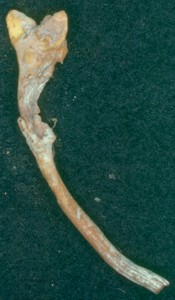
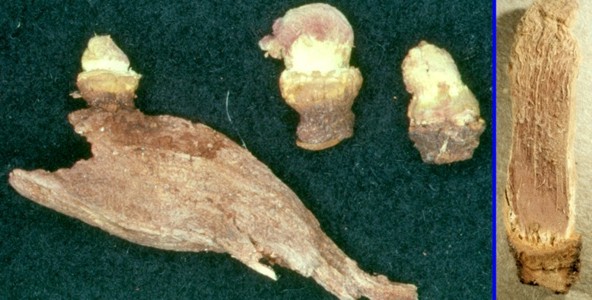 The picture at right illustrates Trichocoma paradoxa, one of the more unusual members of this order. It is found on rotting wood in warm-temperate to tropical regions. The structure of these ascomata is fairly complex, composed of a goblet-shaped and rather woody base supporting a soft mycelial tissue inside, and resembles the end of a small paintbrush. The nearly spherical asci are produced inside the cup where the mycelial part begins. As the spores mature the asci disintegrate and are replaced by a new generation of asci produced in the same place as the old ones. The mycelial tissue gradually elongates and becomes filled with the successive production of purplish ascospores. Older ascomata have quite a long "brush" which releases a cloud of ascospores when it is disturbed. It might be difficult to believe that T. paradoxa really belongs to the Eurotiales were it not that it produces an asexual stage typical of Talaromyces species when grown in a Petri dish. Dendrosphaera eberhardtii, illustrated at far right, is a species also found on rotten wood in tropical regions. It is similar to T. paradoxa but produces multiple "brushes" at the end of a long woody stipe. Like T. paradoxa it has an asexual stage typical of Talaromyces species.
The picture at right illustrates Trichocoma paradoxa, one of the more unusual members of this order. It is found on rotting wood in warm-temperate to tropical regions. The structure of these ascomata is fairly complex, composed of a goblet-shaped and rather woody base supporting a soft mycelial tissue inside, and resembles the end of a small paintbrush. The nearly spherical asci are produced inside the cup where the mycelial part begins. As the spores mature the asci disintegrate and are replaced by a new generation of asci produced in the same place as the old ones. The mycelial tissue gradually elongates and becomes filled with the successive production of purplish ascospores. Older ascomata have quite a long "brush" which releases a cloud of ascospores when it is disturbed. It might be difficult to believe that T. paradoxa really belongs to the Eurotiales were it not that it produces an asexual stage typical of Talaromyces species when grown in a Petri dish. Dendrosphaera eberhardtii, illustrated at far right, is a species also found on rotten wood in tropical regions. It is similar to T. paradoxa but produces multiple "brushes" at the end of a long woody stipe. Like T. paradoxa it has an asexual stage typical of Talaromyces species.

The picture above shows four aspects of Dichlaena lentisci, a species closely related to those of Aspergillus that grows on dry dead leaves. It was originally described in North Africa but has subsequently been found in California in the western USA. The ascomata are simpler than those of Trichocoma paradoxa and are far more compact. In the left panel there are five ascomata growing on a dead leaf. One of them has been cracked open to reveal the spherical cleistothecium inside. The panel second to left is a close-up of one ascoma to show that it has a thick outer layer with a very thin papery layer inside. The papery layer is the wall of the cleistothecium while the outer one is part of the stromatic tissue surrounding it. The third panel puts some of this into perspective. It shows a cross section of a very immature stroma that has not yet developed a cleistothecium inside. The yellow arrow indicates the very early stages of a developing cleistothecium. Examination of developing ascomata in their natural habitat or in Petri dish culture shows that there is first a hard stroma, and later one to three cleistothecia develop inside. The developing cleistothecia crush their way through the stroma so that eventually two layers can be seen; the cleistothecial wall and the stromatal wall. The panel at far right shows the asexual stage that develops when the fungus is grown in the lab. Two other genera, Neopetromyces and Petromyces, are similar to Dichlaena, differing in the colour of the stromata and in the nature of their asexual stages. All three of these genera should possibly be combined with Aspergillus
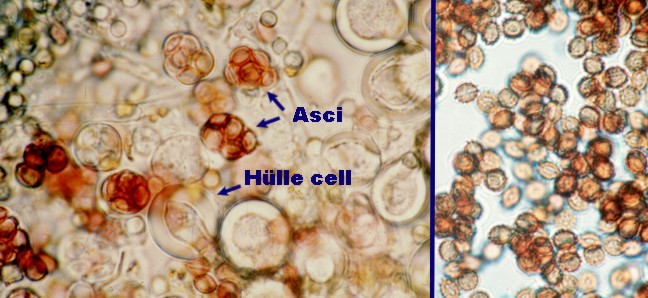
Species of Emericella such as E. nidulans and E. rugulosa illustrated at left are similar to Dichlaena lentisci and may even share habitats with it but differ is some significant ways. Most importantly, the stroma in species of Emericella exists only as masses of "Hülle cells", thick-walled elements resembling the stromatic cells of Dichlaena or Petromyces species but remaining distinct and unconnected to one another. Emericella species are also unique in their red to violet ascospores and characteristic asexual stages. The ascospores are pully-shaped, a type of symmetry commonly produced by members of the Eurotiales. In common with Dichlaena, Neopetromyces and Petromyces, species of Emericella may fit more correctly in Aspergillus
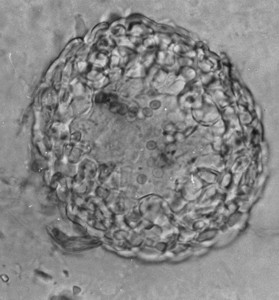
Species of Penicillium differ from the other stromatic groups in having their asci produced directly within hardy stony stromata without any cleistothecial wall at all. The picture at right is a small stroma of Penicillium brefeldianum cut to show the irregular cavity within holding a few ascospores. The cavity should be filled with spores, but these escaped when the stroma was cut. Species of Hemicarpenteles, another segregate of Aspergillus, also produces stromata without cleistothecia.
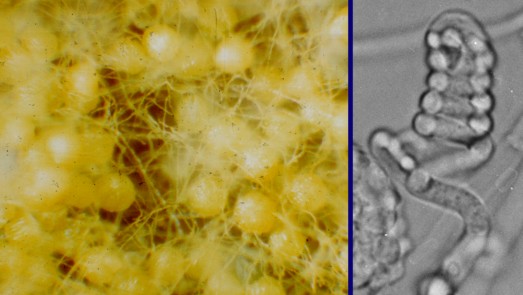
The illustrations at left show the even less complicated structures found in many species of Aspergillus. The panel at far left is a picture taken down into a colony to show the masses of bright yellow cleistothecia characteristic of this genus. We recognize these structures as cleistothecia rather than stromata because they are initiated by prominant ascogonia coils such as the one in the right panel. Ascogonia coils, as explained on the page discussing the Sordariomycetes, are the first stage in sexual reproduction in many Ascomycota and can be taken as a sure sign that the structures arising from them are "true" cleistothecia or perithecia and not stromata.
Species of this section of Aspergillus are among the most common fungi in the home. They have a requirement for dry habitats and will not prosper under moist conditions. They grow on dry but nutritious materials or on substances presenting osmotic stresses not tolerated by most other fungi. In the home you may expect them to occur on dry bread and grains as well as on jams, jellies and syrups. They can also occur on drying plant materials and can become a pest in museums and herbaria (plant collections).